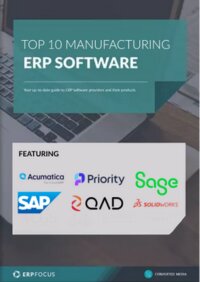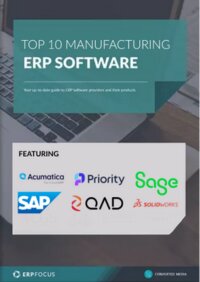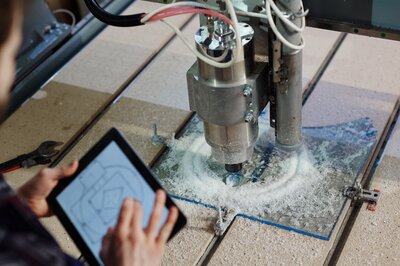How do modern ERP systems benefit SME manufacturers?
Small and medium manufacturers mostly rely on a manual or spreadsheet-model, or a consortium of few softwares, or at the max, a legacy/conventional ERP system to manage their enterprise operations. Low operating margins, slow order-to-cash cycles, delayed payments from customers, increased overhead costs, coupled with the COVID-19 pandemic has made their sustenance more difficult. Many of them have been operating with minimal staff while some of them have shut down their shop altogether.
Modern ERP systems are more advanced in the way they handle business processes and manufacturing workflows. Capabilities such as mobility, cloud-installation, plug-and-play integration, advanced customization etc. help manufacturers to get more speed, agility and efficiency into their operations.
Let us look at a few features of modern ERP systems and their associated benefits to small and medium manufacturers.
Get up and running quickly with flexible installation
Modern ERP systems are built in such a manner that they can be installed anywhere. Either on public or private cloud or on-manufacturing premises. They can even be moved from cloud to on-premises and vice versa, thereby giving utmost operational flexibility. Cloud installation means manufacturers cut down on hardware cost, data storage cost, IT maintenance and a dedicated IT team. Security is not a concern as cloud packages come with advanced data security features.
All ERP features under a single roof
One of the main capabilities that modern ERPs offer is an integrated setup. Sales, purchase, finances, inventory, warehouse, shipment, shop floor, production planning, and scheduling management are tightly integrated with each other and connected to a single database.
This means data entered from all the sources are updated to the centralized database in real-time and reflected across all modules.
Real-time data access & update through mobility
Gone are the days when an .exe file of the ERP had to be installed on every user’s computer and configured separately. Modern ERPs can be opened in any supported browser and accessed from any supported hand-held device such as, smartphones and tablets. This means, personnel can access and update data in real-time from their work centers or from anywhere within the factory. This improves their response time, increases the speed of operations and efficiency.
Build additional tools with low-code development & customization
More enterprises are preferring to adopt ERP systems that provide an option to build custom modules, third-party applications, configure workflows and business logic with minimal coding. With this, manufacturers can cut down on hiring developers or outsourcing to third-party vendors. It reduces the enormous time, resources, cost and effort required to create a custom-module or customize existing ones.
More power to your ERP by quickly integrating with third-party applications
Today’s ERP software can be easily integrated with top-of-the-line manufacturing applications pertaining to nesting, CAD design, barcode & RFID, shipping and logistics, machine monitoring, document management etc. This integration allows manufacturers to automate critical manufacturing workflows, streamline planning, achieve real-time visibility to operations, reduce overhead costs, and obtain maximum utilization of machines, manpower and materials.
More independence to stakeholders through self-service portals
Departments such as the front-desk, procurement, and shipping spend a lot of time fetching data and communicating it to customers, suppliers, and partners. With self-service portals customized for each stakeholder, they can instantly access order details, order status, shipment status, invoice, product details, quality parameters, inventory status etc. This reduces the immense time required to fetch and convey the required information. It also improves communication flow and engagement between the manufacturer and its stakeholder.
Staying on top of operations with advanced data analytics
Modern ERP’s have rich and advanced data analytics features that help manufacturers to gain valuable intelligence and performance data in real-time. These consist of reports, dashboards, analytical graphs, trends, and charts that can be accessed at a click of a button. Also, personalized data tools can be built for specific roles and functions across departments. They can also be accessed from mobile and tablet devices which increases response time and decision-making.
Conclusion
The notion that only large manufacturers can adopt technology to automate their workflows and streamline operations is false. Small and medium manufacturers can also easily adopt a modern ERP system that can make them more efficient, organized, and cost-effective. Overhead costs are drastically reduced, production is efficient and smooth-flowing, order-to-cash cycles are quicker, personnel efficiency and productivity improves, material and machine utilization is at its peak and the enterprise has a clear grip on their finances and profitability.
Free white paper

Top 10 Manufacturing ERP Software Comparison
Compare the best manufacturing ERP systems

Featured white papers
Related articles
-

ERP for make-to-order manufacturing
How can ERP help your make-to-order manufacturing business thrive?
-

Secret KPI: Why Your ERP Implementation Team Matters More Than Software
Learn how Godlan ensures successful ERP implementation for manufacturers with proven strategies &...
-

Shop floor management: 4 ways ERP can improve efficiency
Learn about the shop floor efficiencies that can be realized through the implementation of manufa...



